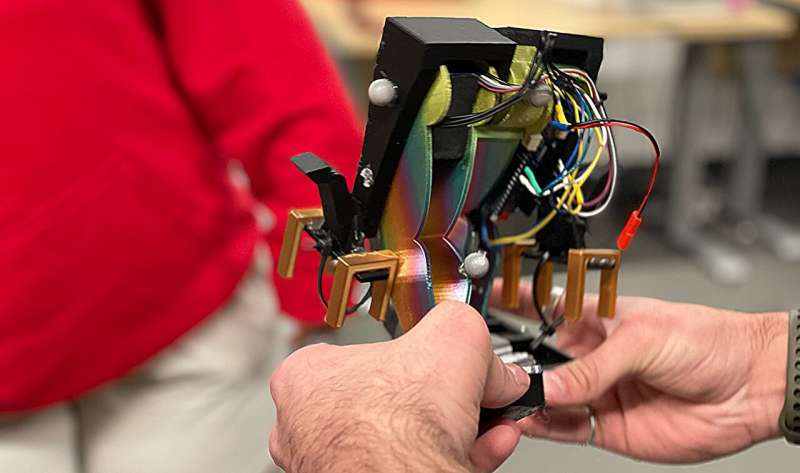This article has been reviewed according to Science X's editorial process and policies. Editors have highlighted the following attributes while ensuring the content's credibility:
fact-checked
preprint
trusted source
proofread
Researchers create 'Mugatu,' the first steerable bipedal robot with only one motor

Small robots are important tools for the investigation and inspection of, well, small spaces. They can carefully place their steps, allowing them to navigate around obstacles, capabilities larger robots do not always possess. This can enable them to inspect machinery or search through rubble in disaster scenarios that other robots cannot reach. However, due to their size constraints, building small robots that can steer themselves and carry their own power sources is difficult.
Aaron Johnson, an associate professor of mechanical engineering, and Sarah Bergbreiter, a professor of mechanical engineering, and their team of researchers revolutionized the field with the construction of "Mugatu," the first steerable bipedal robot that contains only a single motor. Mugatu is also self-contained and self-starting; open-loop stable in its gait; and has controlled left, right, and straight steering. The design uses two rigid bodies and one actuator, a simple walker design that is still capable of complex motions of other robots.
"The first direction of the project was aimed at simplifying the way robots walk as much as possible," says first author James Kyle, a recent mechanical engineering master's and bachelor's graduate. "Once we understand how scaling affects locomotion, it can be extremely useful for taking something that already exists and scaling it up or down to do things like fit through smaller pipes or carry more load."
Another team member, undergraduate mechanical engineering student Kendall Hart, worked on the robot's current sensor, the part of the robot that allowed the team to calculate the total cost of transport, the amount of energy used over a certain distance.
"Before I came into the lab, I had a vague understanding of MATLAB, (a programming and numeric computing platform) but working on this project allowed me to apply what I learned in class. When we were working on implementing the current sensor, there was a lot of debugging there, but now it's made me more confident in debugging without my mentors," Hart says.
Nicknamed "The LEGO Project," the team aims to eventually get these walkers down to the size of a LEGO. "It's going to take a while because the mechanics of everything changes as you start down-sizing," Hart says. "But what makes the project so special and so impactful in the community is because it's never been seen before." The drastic simplification of this walking device combined with its single degree of freedom is a promising step (pun intended) toward highly efficient small robots.
The collaborators on this project include James Kyle, Justin Y. Kim, Kendall Hart, Sarah Bergbreiter, and Aaron Johnson.
More information: James Kyle et al, The Simplest Walking Robot: A bipedal robot with one actuator and two rigid bodies, arXiv (2023). DOI: 10.48550/arxiv.2308.08401



















